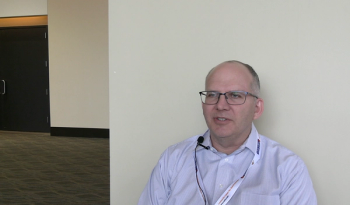
Understanding Molecular Interactions with Advanced FT-IR Spectroscopy and Imaging
Advanced vibrational spectroscopic techniques such as Fourier transform infrared (FT-IR) and attenuated total reflection (ATR)-FT-IR spectroscopic imaging are important tools for understanding molecular interactions and using them to help engineer new products and processes. Sergei G. Kazarian, Professor of Physical Chemistry at the Department of Chemical Engineering at Imperial College London, UK, has used these advanced imaging techniques for applications as varied as studying crude oil fouling, analyzing pharmaceutical formulations in microfluidic channels, examining biological systems and biopsy samples, and investigating the pigment-oil interaction in priceless paintings at the microscale level. We recently spoke with him about this research.
Advanced vibrational spectroscopic techniques such as Fourier transform infrared (FT-IR) and attenuated total reflection (ATR)-FT-IR spectroscopic imaging are important tools for understanding molecular interactions and using them to help engineer new products and processes. Sergei G. Kazarian, Professor of Physical Chemistry at the Department of Chemical Engineering at Imperial College London, UK, has used these advanced imaging techniques for applications as varied as studying crude oil fouling, analyzing pharmaceutical formulations in microfluidic channels, examining biological systems and biopsy samples, and investigating the pigment–oil interaction in priceless paintings at the microscale level. We recently spoke with him about this research.
One of your recent publications discusses in situ attenuated total reflection–Fourier transform infrared (ATR-FT-IR) spectroscopic imaging monitoring of asphaltene precipitation from benzene solution and crude oil induced with high-pressure CO2 (1). What makes ATR-FT-IR imaging a good choice for monitoring this process? What important conclusions were drawn from this research?
Firstly, this research is relevant to understanding crude oil fouling, a problem that has immense economic and energy implications. In this work we demonstrate an approach of the ATR-FT-IR spectroscopic imaging applied in situ to investigate the stability and behavior of asphaltenes dissolved in different media (benzene and crude oil) at high-pressure CO2 conditions. The precipitation of asphaltenes from benzene solutions and crude oil induced by high-pressure CO2 has been studied in situ. This is the first time that the dynamics of precipitation have been observed with ATR-FT-IR spectroscopic imaging, which was used to detect the initial stages of precipitation, to monitor the dynamics of the formation and growth of deposited particles, and to chemically analyze the constituents of the deposits observed under high-pressure conditions.
ATR-FT-IR imaging is the method of choice to study precipitation of asphaltenes because the strong absorption of crude oil in the infrared region makes transmission FT-IR measurements very challenging. ATR-FT-IR spectroscopic imaging probes a thin layer (a few micrometers) of the sample at the bottom of the high-pressure spectroscopic cell, which provides the unique opportunity to mimic and study the behavior of crude oil at the bottom of the oil container in situ.
It was found that asphaltenes with oxygen-containing functional groups, which are capable of forming specific Lewis acid-base interactions with CO2, have been observed to precipitate from benzene solution and crude oil at such conditions. Subsequently, based on the obtained spectroscopic data, the mechanism of CO2-induced precipitation of asphaltenes has been proposed. The obtained results may impact areas as diverse as crude oil production, oil recovery, CO2 flooding, crude oil fouling, and relevant design or operations by helping oil companies improve their energy efficiency and environmental impact (which ultimately may cut petrol prices). This research is the result of collaboration with Prof. O.N. Martyanov at the Boreskov Institute of Catalysis in Novosibirsk, Russia, which celebrates its 60th anniversary this year. Notably, the Society of Applied Spectroscopy, of which I am a Fellow and Editor of its flagship journal, Applied Spectroscopy, also celebrates its 60th anniversary.
In a second study (2), you used in situ ATR–FT-IR spectroscopy for imaging pharmaceutical formulations in microfluidic channels to study drug release. What other spectroscopic techniques have been used for this type of study, and what are the advantages of your FT-IR approach over those previous techniques?
Microformulations are of significant interest because they can be used to facilitate the development of a wide range of drug delivery systems, including tablet compacts and capsules. The following key question must be answered: How can informative data about multiple microformulations be obtained simultaneously for direct comparison in different microfluidic channels? Recently, a droplet-based microfluidic immunosensor for detection of melamine has been reported that uses a fluorescence polarization method. Ultraviolet (UV) analysis is one method that has shown potential to collect information of drug release in parallel channels using only a few milligrams of the sample. However, no spatial information about the physical or chemical processes occurring within the formulations is revealed and this approach, to date, has not been successfully applied for high-throughput screening approaches. Weitz and coworkers (3) applied fluorescence microscopy to study drug release from microparticles in a microfluidic chip using added dyes, but this approach lacks chemical specificity. However, ATR-FT-IR spectroscopic imaging, an inherently label-free approach, has shown potential for high-throughput screening of static formulations, where spatially resolved information from the different chemical components in the microformulations can be distinguished and structural changes detected, unlike in other approaches. In our macro ATR-FT-IR spectroscopic imaging approach, a combination of three exciting modern technologies was used for the first time: unique custom designed microfluidic chips; 3D printing technologies (using a microdrop system) for preparing pharmaceutical microformulations; and ATR-FT-IR chemical imaging to understand drug release and dissolution of microformulations. This approach reveals molecular-level insight into the mechanism of dissolution of microformulations and opens a new area of research with direct implications for drug delivery.
A third study in your lab involved mid-infrared spectroscopic imaging of biological systems and biopsy samples. Optical improvements were demonstrated using FT-IR microscopy when conventional sources of infrared radiation were used, as well as application of quantum cascade lasers (QCLs) (4). What challenges were overcome in this study? What are the potential benefits of this approach for clinical analysts?
Indeed, this cited article was largely focused on discussion of optical approaches introduced in my laboratory (
The use of discrete-frequency QCL approaches, also discussed in this article, provides an opportunity for data reduction without significant loss of achieved classification and also offers a possibility for analysis of much greater areas of samples than were previously feasible using conventional infrared sources. This approach facilitates analysis of many samples in a high-throughput manner. We have presented promising preliminary examples of the use of a QCL-based system for obtaining chemical images of esophageal biopsy, but this method can be enhanced further when combined with our correcting lens approach. Recent publications by several other research groups further demonstrate the use of such QCL system for histopathology-for example, by imaging of adenocarcinoma colorectal tissue and high-speed scanning of an entire liver biopsy (5). Furthermore, a very interesting application of QCL for high-throughput analysis of biofluids has recently been demonstrated by Matthew Baker and coworkers (6,7) and by Wrobel and Bhargava for tissue analysis (8),
You have also conducted a study of Jackson Pollock’s masterpiece painting Alchemy, in which ATR-FT-IR spectroscopic imaging was used for investigation at the microscale level of the pigment–oil interaction in the painting (9). What were the main questions you were attempting to answer in this study?
Yes, this is another exciting application of ATR-FT-IR spectroscopic imaging and I was delighted to collaborate on this research with Italian scientists from Perugia and the Peggy Guggenheim Collection in Venice on spectroscopic studies of microscopic samples from the painting by Jackson Pollock, who is described as one of the greatest figures in the abstract expressionist movement of the 20th century and has produced masterpieces using his unique technique. He routinely used a traditional oil paint (zinc oxide in linseed oil), but was unaware that this type of paint presented a potential threat to the conservation of his paintings. In this work, we applied micro ATR-FT-IR spectroscopic imaging, which we have previously used to study the degradation process of paintings from the National Gallery, London. In this work, we used this approach to detect the mechanism of detrimental formation of zinc soaps occurring inside the painting by Jackson Pollock, thus resulting in its degradation. ATR-FT-IR imaging has helped us to explain that the damage of the painting was related to the formation of zinc soaps around areas where a jellifying agent (aluminum stearate hydroxide) was present that was added in the paint formulation. This finding led to an explanation that this jellifying agent accelerated the formation of zinc soap that usually forms due to the interaction of zinc oxide with fatty acids present in the oil binder of the painting. These chemical processes were reliably assessed due to the high spatial resolution of micro ATR-FT-IR spectroscopic imaging. Previously, we used this spectroscopic approach to analyze a cross-section of hair and live cancer cells, to study atherosclerosis in arterial tissues, to investigate pharmaceutical tablets, and for many other applications.
This spectroscopic study of Pollock’s masterpiece Alchemy may help conservation scientists to preserve this, and other, important objects of cultural heritage.
In a very recent study (10), you used ATR-FT-IR spectroscopy to investigate the use of supercritical CO2 in the processing of polymeric materials in place of organic solvents. What are the advantages and possible disadvantages of using ATR-FT-IR spectroscopy for this application?
This recent article explains why in situ ATR-FT-IR spectroscopy is a powerful method of choice for studies of polymeric materials processed with supercritical CO2. This approach was pioneered in my laboratory and has since been used by many other researchers in this field. This topic is of significant importance because it has direct implications in CO2 capture technologies and supporting the drive toward greener solvent alternatives. This article explains why supercritical CO2 is the method of choice for processing environmentally friendly materials. There are many advantages of using this ATR-FT-IR spectroscopic approach, which include chemical specificity of quantitative in situ analysis by using miniature spectroscopic cells that facilitate the use of a small amount of sample and also make these high-pressure spectroscopic experiments safer.
What are the next steps in your research with infrared spectroscopy?
I expect to continue with other new developments in FT-IR spectroscopic imaging and their application to a broad range of novel research areas. One of our most recent research activities utilizes in situ FT-IR spectroscopy and imaging to understand key processes occurring in chromatographic columns. This work aims to reveal new insights into protein behavior during isolation, so the next steps will be made in this direction and we expect collaboration in this field with biopharmaceutical companies. I would also expect new developments into the design of new microscopes and spectrometers, such as combining the use of a QCL source with a microscope equipped with added lenses, hemispheres, or an ATR crystal, or both, for greater spatial resolution measurements that would allow the acquisition of higher quality spectroscopic images. These approaches, combined with machine learning techniques, may be applied to cancer diagnosis.
References
1. A.A. Gabrienko, O.N. Martyanov, and S.G. Kazarian, Energy Fuels30, 4750–4757 (2016). doi: 10.1021/acs.energyfuels.6b00718
2. A.V. Ewing, G.S. Clarke, and S.G. Kazarian, Biomicrofluidics10, 024125 (2016). doi: 10.1063/1.4946867
3. M. Windbergs and D.A. Weitz, Small7(21), 3011–3015 (2011).
4. J.A. Kimber and S.G. Kazarian, Anal. Bioanal. Chem.409, 5813–5820 (2017). doi: 10.1007/s00216-017-0574-5
5. B. Bird and J. Rowlette, Analyst.142(8), 1179–1184 (2017).
6. C. Hughes, G. Clemens, B. Bird, T. Dawson, K.M. Ashton, M.D. Jenkinson, A. Brodbelt, M. Weida, E. Fotheringham, M. Barre, J. Rowlette, and M.J. Baker, Sci. Rep.6, 20173 (2016).
7. M.J. Baker, H. Byrne, J. Chalmers, P. Gardner, R. Goodacre, A. Henderson, S.G. Kazarian, F. Martin, J. Moger, N. Stone, and J. Sulé-Suso, Analyst (2018). doi: 10.1039/C7AN01871A
8. T.P. Wrobel and R. Bhargava, Anal. Chem.90(3), 1444–1463 (2018). doi: 10.1021/acs.analchem.7b05330
9. F. Gabrieli, F. Rosi, A. Vichi, L. Cartechini, L.P. Buemi, S.G. Kazarian, and C. Miliani, Anal. Chem.89, 1283–1289 (2017). doi: 10.1021/acsanalchem.6b04065
10. A.V. Ewing and S.G. Kazarian, The Journal of Supercritical Fluids134, 89–96 (2018) https://doi.org/10.1016/j.supflu.2017.12.011
Newsletter
Get essential updates on the latest spectroscopy technologies, regulatory standards, and best practices—subscribe today to Spectroscopy.





